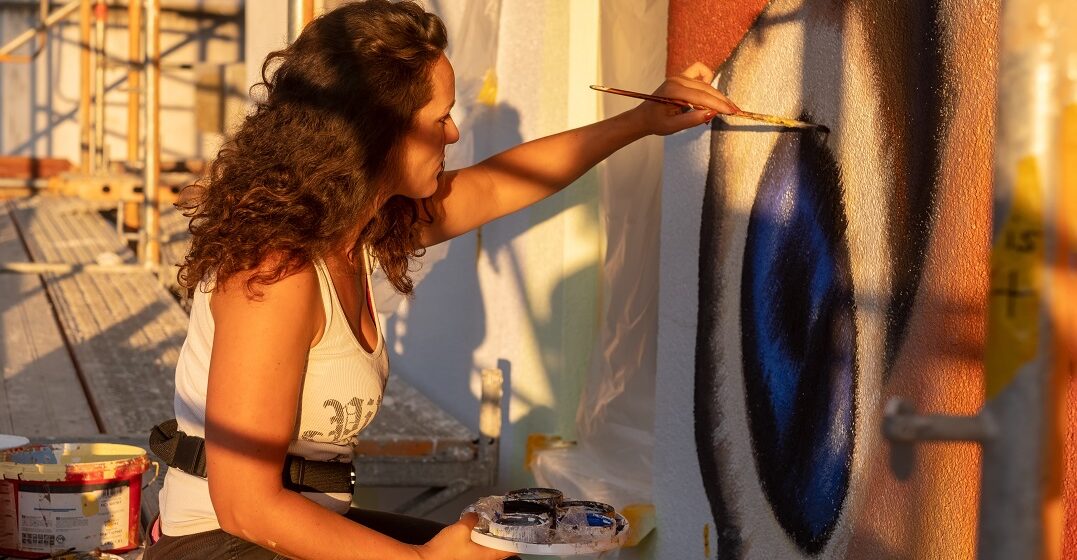French street art: 5 artists you should know

France is a country that offers many wonders, from delicious food and wine to stunning landscapes and architecture. But perhaps nothing is more integral to French culture than art. There’s no shortage of incredible museums in France, but there’s a specific type of French art that you won’t find hanging in galleries: French street art.
In recent decades, many artists have taken to painting and designing artworks in the streets of Paris, Marseilles and beyond. With the exploding popularity of French street art, now is the time to learn about the most notable French street artists. Here are five of our favorites — their lives, their stories and the artworks they’re most famous for.
Learn languages at your pace
1. Ernest Pignon-Ernest
Let’s start with one of the pioneers of French street art, Ernest Pignon-Ernest. This famous artist was born in Nice in 1942 to a family of sports fans. However, from a young age, he showed much more interest in art. The turning point in his life was when he discovered Picasso in a French magazine. This inspired him and led him down the path of creativity in the form of painting and visual art.
Pignon-Ernest took his first step towards street art in 1966, when he learned that France’s Nuclear Strike Force was a mere few kilometers away from him. Inspired by this and by the tragic 1945 Hiroshima nuclear bombing, he painted a monochromatic image of a man carrying someone in their arms. This politically charged and emotionally jarring piece laid the foundation for his future as a street-art designer in France.
Pignon-Ernest’s work can be described as monochromatic and dense with political meaning. Location is a fundamental part of his creative practice; his designs often speak to historical or current events involving their place of origin.
2. Miss.Tic
Another notable example of street art in France is the late Miss.Tic, a Parisian woman who experienced a difficult childhood. She lost half her family to a car accident when she was 10 and later lost her father. Despite this trying start in life, she discovered a passion for art and spent some time in the United States accumulating inspiration. She produced her first official piece of street art upon her return to France in 1985.
Miss.Tic’s work is mainly characterized by stencils (often of women) accompanied by text. Her pieces hold a lot of meaning for women around the world and tend to deal with the theme of freedom. Her most famous street-art pieces (or art urbain en français) include Je joue oui and Le pouvoir ne protège pas, il se protège. Sadly, this talented French street artist died at age 66 from an unknown illness.
3. JR (Jean René)
French street artist JR produces a different kind of art — he’s often labeled a photograffeur, which is a portmanteau of the French words for “graffiti artist” and “photographer.”
As a teen, JR tried his hand at typical forms of street art. But after finding a camera, he began taking photos of his work and posting them on the streets. This led to a creative breakthrough, and he is now a famous French street artist with a distinctive style of black-and-white art posted all over the the streets (which he calls “the largest art gallery in the world”).
JR’s street art gives a voice to communities and people who may not otherwise have one. His first famous street-art piece was titled Portraits of a Generation and included images of young men in a Parisian suburb where riots were taking place. With this controversial piece, he wanted to challenge people’s perceptions of these men as skewed by the media. Other notable works include Face 2 Face, a collection of images of Israelis and Palestinians, and Woman Are Heroes, a homage to women who suffer during conflicts.
4. Invader
French street artist Invader’s most famous work involves mosaics based on video games from the 1970s and ‘80s. (These games include Pac-Man and Space Invaders, the latter of which inspired his pseudonym.) He originally studied at the École des Beaux-Arts in Paris and, upon graduating, he began creating these funky mosaics in the streets of Paris. Today, Invader’s famous creatures grace the walls of more than 70 cities across the world — a reflection of his “invasion strategy.”
Invader is heavily inspired by digital culture, which he describes as “the heartbeat of our world.” He aims to challenge the traditional art world by posting his artwork in public spaces on the streets of France and beyond. His colorful mosaics can be found in far-flung cities such as Paris, Bangkok and Istanbul.
5. Blek le Rat
Like Miss.Tic, Blek le Rat specializes in stencils — so much so that this Parisian artist has been dubbed the “father of stencil graffiti.” He followed a more traditional path in the sense that he studied painting and printmaking at the École des Beaux-Arts. His first work was (fittingly) a stencil of a rat, an animal he hailed as the “only free animal in the city.”
Nowadays, his artworks are more socially conscious and tackle subjects such as the environment and homelessness. His work is characterized by stencils, photos and spray paint. Famous pieces include Man Who Walks Through Walls and Beggar. This French street artist is so talented that even the renowned British street artist Banksy has cited him as an important influence.
Influential artwork
All of these artists help to make French street art an important part of French culture and the art world at large. Defying the notion that art should be contained within museum collections and private galleries, they create works that are specifically meant to be available to the masses. In doing so, they provide a wonderful and rich addition to the culture of the country they call home.













